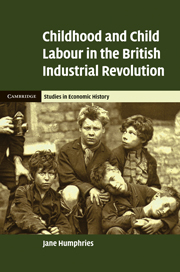7 - Starting work
Published online by Cambridge University Press: 06 December 2010
Summary
Introduction
The great virtue of approaching child labour through autobiography is the ability to see the issue in context, to be able to trace the labour supply to its origins in family and community. Chapter 2 suggested a number of interconnections between child labour and the economic and social changes of the eighteenth and nineteenth centuries and concluded that the industrial revolution, as now understood, may well have both unleashed a boom in children's work and itself been fed by children's work. The current chapter explores this hypothesis at the micro-level in terms of factors that likely promoted or retarded entry into the labour force such as social norms, a child's family circumstances and local employment opportunities. In so doing, it builds on key findings from earlier chapters: first, an apparent precocious dependence on men and men's earnings, manifest in attitudes to mothers and fathers and perceptions of their duties; and, second, the extent of fatherlessness, and particularly de facto fatherlessness, in the eighteenth and early nineteenth centuries. Together these two features imply a ‘breadwinner frailty’. Dependence on men's earnings meant that the loss or interruption of male support, an all too common experience in these years, jeopardized families' survival. Like its close relation ‘nuclear hardship’, the precocious adoption of this particular family form left individuals vulnerable when families failed. Unless the authorities were prepared to let mothers and children perish (and they were not) an alternative system of support was needed.
- Type
- Chapter
- Information
- Childhood and Child Labour in the British Industrial Revolution , pp. 172 - 209Publisher: Cambridge University PressPrint publication year: 2010
- 2
- Cited by

